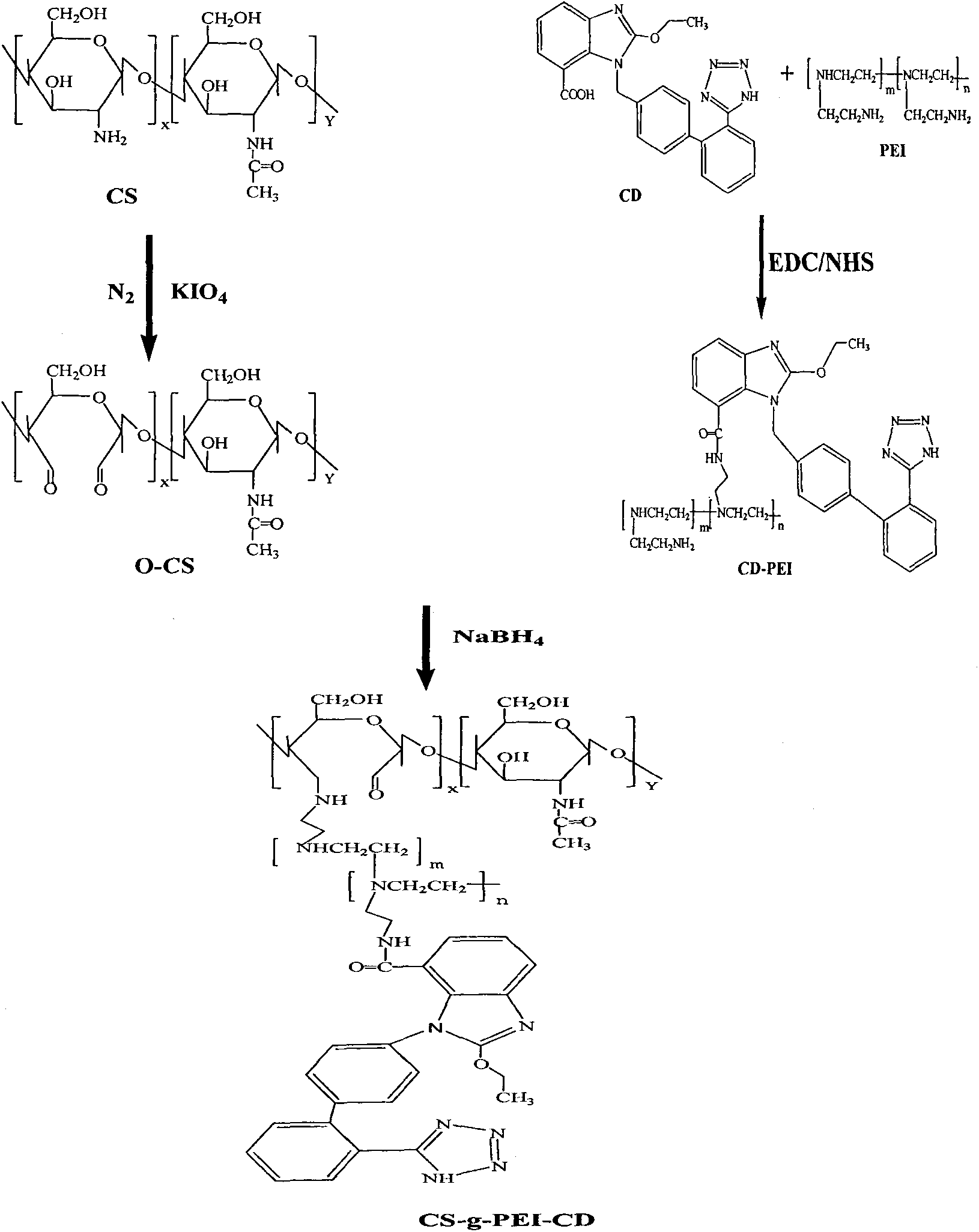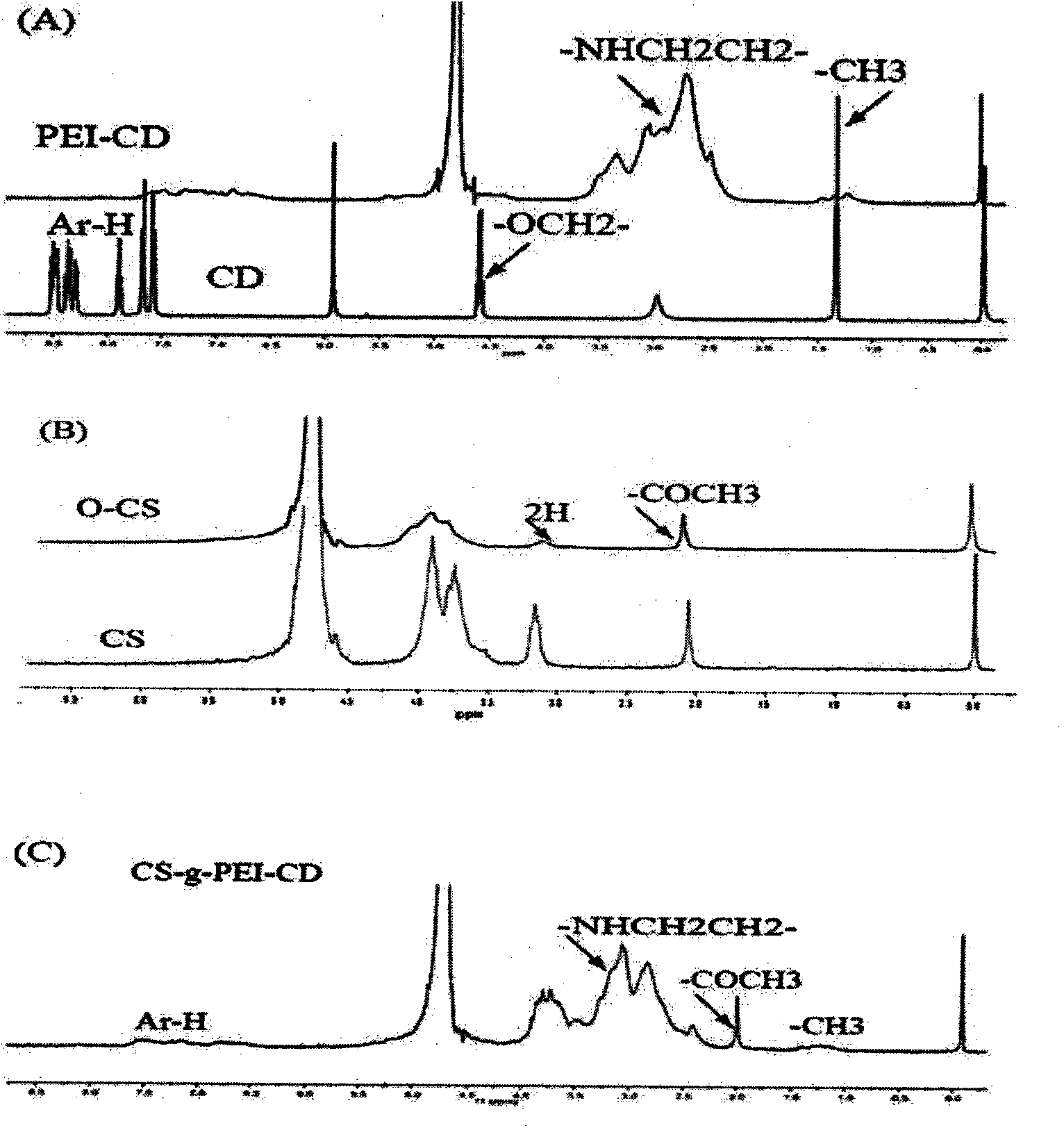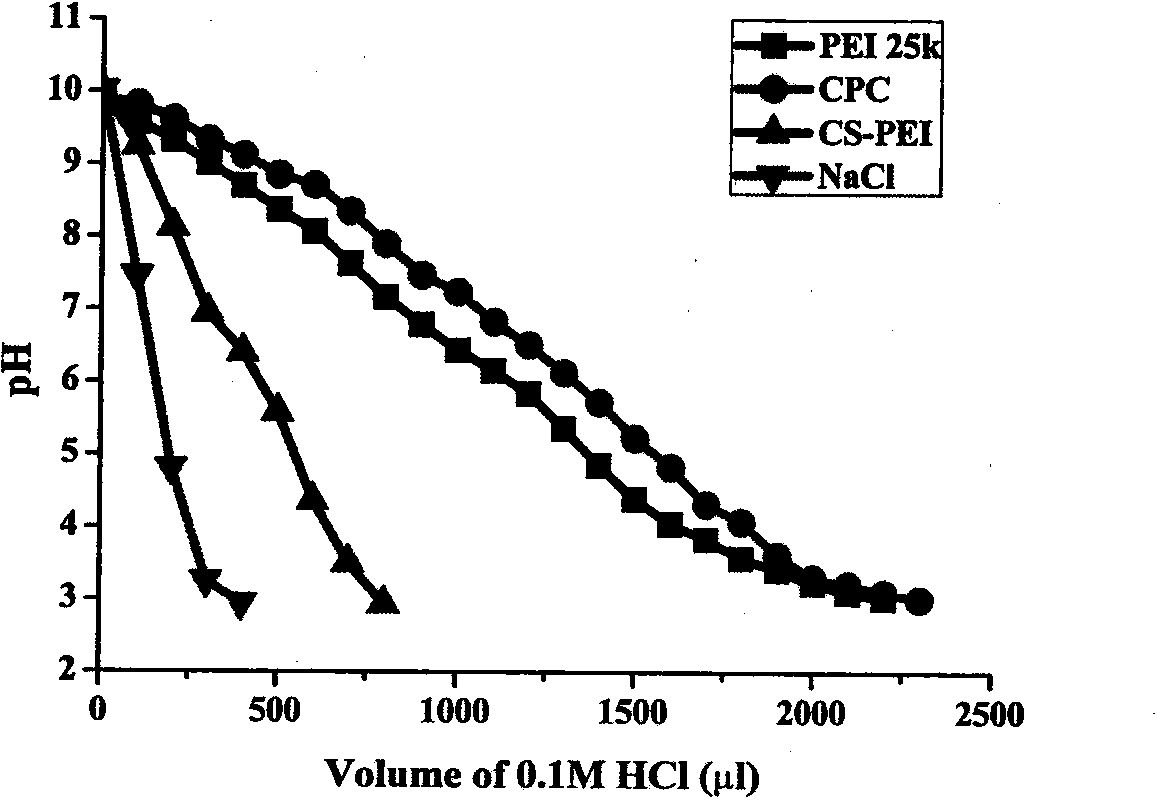Multifunctional cationic polymer gene vector, and preparation method and application thereof
A cationic polymer and multi-functional technology, applied in gene therapy, active ingredients of heterocyclic compounds, drug combination, etc., can solve the problems of poor cell targeting, achieve low cytotoxicity, improve low transfection efficiency, and strong cell adhesion Adjunctive effect
- Summary
- Abstract
- Description
- Claims
- Application Information
AI Technical Summary
Problems solved by technology
Method used
Image
Examples
Embodiment 1
[0045] Embodiment one: the synthesis of cationic polymer chitosan-g-polyethyleneimine-candesartan (CS-g-PEI-CD, CPC)
[0046] 1) Activation of Candesartan (CD)
[0047] Weigh 0.0264g candesartan and dissolve it in 2ml N,N-dimethylformamide (DMF), and weigh 2 times the molar amount of 1-(3-dimethylaminopropyl)-3-ethylcarbodiethylene Dissolve amine hydrochloride (EDCI) and 3 times the molar amount of N-hydroxysuccinimide (NHS) in 4ml of DMF, add it dropwise to the candesartan solution, and react with magnetic stirring for 1 hour at room temperature to obtain activated of candesartan.
[0048] 2) Synthesis of candesartan-polyethyleneimine conjugate (CD-PEI)
[0049] Weigh 0.0568g of polyethyleneimine and dissolve it in 6ml of water-N,N-dimethylformamide (1:2) mixed solvent, add the activation solution of above-mentioned candesartan to the polyethyleneimine solution dropwise, at room temperature The reaction was carried out under magnetic stirring for 24 hours, acetone was adde...
Embodiment 2
[0057] Embodiment two: the mensuration of cationic polymer buffer capacity
[0058] 6mg of the cationic polymer CPC prepared in Example 1 was dissolved in 30ml of 150mM NaCl solution, then the pH of the solution was adjusted to 10.0 with 0.1M NaOH, and then titrated with 0.1M HCl until the pH dropped to 3.0. Record the total volume of hydrochloric acid added and the corresponding pH of the solution at this time, and draw the hydrochloric acid volume-pH curve. 150mM NaCl solution, CS-PEI (see comparative example) and PEI25k were used as blank control, negative control and positive control respectively, the results are shown in the attached image 3 . The buffering capacity of the polymer is calculated according to the following formula:
[0059] (ΔH 上 样品 -ΔH 上 NaCl ) / N mol ×100%
[0060] In the formula, ΔH 上 It is the number of moles of hydrochloric acid consumed by the sample solution from pH 7.4 to 5.0 during titration. N mol is the number of moles of all protonata...
Embodiment 3
[0062] Example 3: Preparation of CPC / DNA complex and gel retardation experiment
[0063] The polymer CPC prepared in Example 1 was dissolved in PBS buffer (pH 7.2-7.4), and the plasmid DNA was dissolved in deionized water. The mass of fixed plasmid DNA (2 μg DNA) was 0, 0.25, 0.5, 0.75, 1, 1.5, and 2 according to the mass ratio of carrier and plasmid DNA. After mixing the polymer solution and plasmid DNA solution, vortex for 15 seconds, and let it stand at room temperature. Set it aside for 30 minutes to obtain the CPC / DNA complex solution. Take 20 μl of the complex solution for agarose gel electrophoresis to observe the DNA retardation. Electrophoresis conditions: 0.8% agarose (with GoldViewer TM ), 0.5×TBE buffer, voltage 90V, electrophoresis time 60min, the results are shown in the attached Figure 4 .
[0064] attached Figure 4 Middle lane 1 is the plasmid DNA control, and lanes 2 to 7 correspond to the mass ratios of vector and plasmid DNA being 0.25, 0.5, 0.75, 1, ...
PUM
| Property | Measurement | Unit |
|---|---|---|
| molecular weight | aaaaa | aaaaa |
| degree of substitution | aaaaa | aaaaa |
| degree of grafting | aaaaa | aaaaa |
Abstract
Description
Claims
Application Information
 Login to View More
Login to View More - R&D
- Intellectual Property
- Life Sciences
- Materials
- Tech Scout
- Unparalleled Data Quality
- Higher Quality Content
- 60% Fewer Hallucinations
Browse by: Latest US Patents, China's latest patents, Technical Efficacy Thesaurus, Application Domain, Technology Topic, Popular Technical Reports.
© 2025 PatSnap. All rights reserved.Legal|Privacy policy|Modern Slavery Act Transparency Statement|Sitemap|About US| Contact US: help@patsnap.com



